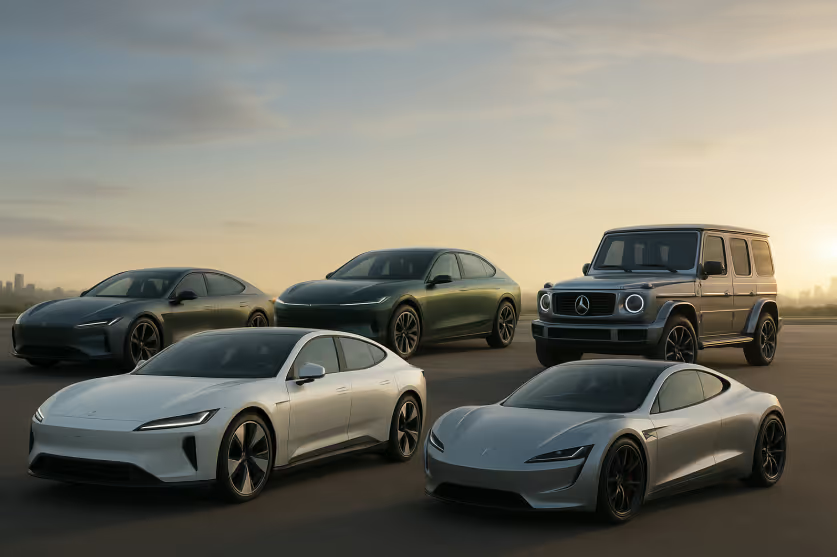Stay informed with our newsletter.
.webp)

.webp)

The coming years are set to redefine the automotive world with groundbreaking models arriving in 2025 and beyond. From cutting-edge electric sedans and futuristic sports cars to luxury roadsters and sustainable SUVs, automakers are pushing boundaries in design, performance, and technology. These upcoming cars promise thrilling speed, innovative features, and eco-friendly engineering, shaping the next era of driving. Enthusiasts can look forward to a mix of power, style, and sustainability on the road.

The automotive industry is heading into one of its most exciting eras. By 2025 and beyond, the world will see a new generation of vehicles that push boundaries in performance, sustainability, and technology. From sleek electric sedans and powerful SUVs to futuristic sports cars, automakers are redefining mobility for the next decade. For the USA, already a global hub for innovation and consumer demand, these upcoming vehicles promise to reshape the driving experience in a big way.
The next wave of cars reflects three defining global trends:
These themes are embodied in the most exciting launches set to roll out globally.
Polestar is introducing a four-door luxury EV that combines performance with eco-conscious design. With nearly 870 hp from dual motors, an 800V charging system, and lightweight bonded aluminum, the Polestar 5 is positioned as a strong rival to the Porsche Taycan and Tesla Model S.
Tesla’s second-generation Roadster is perhaps the most hyped electric supercar. Promising sub-2 second acceleration from 0–60 mph and a range of up to 600 miles, it’s engineered for jaw-dropping speed. Rumors of optional cold-gas thrusters only add to its futuristic appeal.
Honda is rebooting its EV presence with the 0 Saloon, a minimalist yet futuristic sedan that offers AI-driven cabin personalization, fast charging, and driver-assist technologies. Expected in 2026, it balances efficiency with everyday usability.
The Lotus Emeya is a “hyper-GT” that embodies high-performance electrification. Producing up to 905 hp and capable of 0–62 mph in 2.78 seconds, it competes directly with performance EV sedans like the Taycan Turbo GT. With nearly 380 miles of range, it promises to be both thrilling and practical.
Seen as the spiritual successor to the LFA, the Lexus LFR is expected to debut with a twin-turbo V8 hybrid system generating between 600–800 hp. Combining Japanese engineering finesse with hybrid power, it will likely target elite sports car buyers.
Caterham, known for ultra-light sports cars, is preparing its first EV. The Project V aims for agility and driver engagement, weighing just under 1,200 kg. It’s a sports car purist’s EV, lightweight, fast, and driver-focused.
The U.S. market will be a key battleground for EVs and hybrids, with domestic automakers and international players all rolling out headline-grabbing models. Some highlights include:
Ford is betting big on electrification, and the Explorer EV is central to its plan. A family-friendly SUV, it promises practicality, advanced tech, and competitive range, making it a strong choice for American households.
The iconic Silverado goes electric in 2025. With up to 400 miles of range, impressive towing capacity, and rugged design, it’s tailored for both work and play. It represents how EVs are moving into the heart of the American automotive identity: trucks.
Following the success of the R1T and R1S, Rivian plans to introduce the more affordable R2 lineup. Designed to bring EV adventure to a broader audience, it will offer Rivian’s off-road capability in a smaller, more city-friendly package.
Lucid Motors, famous for the Air sedan, is entering the SUV segment with the Gravity. Expected to deliver a luxurious interior, cutting-edge tech, and up to 440 miles of range, it’s a high-end EV SUV designed for families and executives alike.
Mercedes-Benz is electrifying its legendary G-Class with the EQG. Keeping the iconic boxy design but adding advanced electric powertrains, it will appeal to luxury SUV buyers who also want sustainability.
The U.S. is not just a consumer market but also a driver of innovation. Automakers often launch EVs in the U.S. first due to its infrastructure growth, government incentives, and strong consumer appetite. Federal and state-level rebates, combined with a growing charging network, are encouraging buyers to make the switch.
Additionally, American roads and lifestyles influence vehicle design, large SUVs, powerful trucks, and luxury sedans dominate sales, so electrifying these categories is key. Models like the Silverado EV and Explorer EV are proof that automakers are listening to the American market.
The cars of 2025 and beyond show that the future of driving will be cleaner, faster, and smarter. For the U.S., this transformation will impact everyday commuting, long-distance travel, and even work fleets. Whether it’s the hyper-performance Tesla Roadster, the luxurious Lucid Gravity, or the practical Ford Explorer EV, each car reflects a different piece of America’s diverse driving culture.
Globally, the emphasis on sustainable materials, AI-driven systems, and next-gen battery technologies is reshaping how cars are made and driven. The U.S. will play a central role in adopting and advancing these innovations, ensuring drivers experience the very best of what the next decade has to offer.
Great cars still to come in 2025 and beyond are more than just new models, they represent a revolution in how we think about mobility. From global icons like the Polestar 5 and Lotus Emeya to U.S.-centered launches like the Silverado EV and Explorer EV, the automotive future is diverse and electrifying. The next generation of vehicles will not only change how Americans drive but also how the world views performance, sustainability, and innovation on four wheels.
For questions or comments write to contactus@bostonbrandmedia.com
